(Sample Material) Online Coaching for CAPF (AC): Geography - "World Geography (Part - 1)"
Online Coaching for UPSC Central Armed Police Forces (AC) Written Examination
Geography
World Geography (Part - 1)
Space
- Everything that exists, from the Galactic Superclusters to the tiniest subatomic particles, comprises the Universe.
- Among the various theories on the origin of universe including the steady state and the pulsating universe theories, the one most widely accepted has been the Big Bang theory.
- This theory traces the origin to a primordial explosion of super-compressed cosmic matter, the energy of which has sustained the continuous expansion of universe.
- However, some recent theories have questioned the very fundamentals of the Big Bang theory.
- As for the age of Universe, scientists agree that it is about 11 to 17 aeons or billion years.
- The Universe comprises Galaxies that are huge congregation of stars held together by the forces of gravity.
Black Holes
- Black Holes result from the collapse and compaction under gravity, of a star of mass greater than three times that of the sun, at the end of its life-cycle. Its density becomes so great that nothing, not even light, can escape from its gravity.
- It is so-called because it cannot be viewed directly.
- S Chandrashekhar, the renowned Indian Physicist had predicted an upper limit to the mass of stars, above which they either explode or form a black hole.
- This is referred to as the Chandrashekhar Limit.
Unit of Measurement
1. Light year: A light-year is a unit of distance. It is the distance that light can travel in one year. Light moves at a velocity of about 300,000 kilometers (km) each second. So in one year, it can travel about 10 trillion km. More precisely, one light-year is equal to 9,500,000,000,000 kilometers. Solar system is less than one light day across.
2. Astronomical Unit (A.U.): The Astronomical Unit is the average distance between the Sun and Earth. Its value is 149,597,870 km (about 93 million miles). There are a variety of ways to measure it, but the most accurate is to fly spacecraft to various planets. It is used to measure distances within the solar system. The distance between sun and Pluto averages 39AU. In terms of space dimensions, a light year is made up of about 60,000 Aus.
3. Parsec: The parsec (symbol pc) is a unit of length used in astronomy. The length of the parsec is based on the method of trigonometric parallax, one of the oldest methods for measuring the distances to stars. The name parsec stands for “parallax of one second of arc”, and one parsec is defined to be the distance from the Earth to a star that has a parallax of 1 arc second. The actual length of a parsec is approximately 3.086x1016 m, or about 3.262 light-years.
- Optical and radio telescope studies indicate the existence of about 100 billion galaxies in the visible universe.
- Galaxies occur in three structural forms: Spiral, Elliptical and Irregular.
- Spiral galaxies have a central nucleus with great spiraling arms trailing around them, examples include our Milky Way and the Andromeda galaxies.
- Elliptical galaxies are without spiraling arms.
- Irregular ones have no clear shape.
- Stars account for most of the galactic mass.
- They tend to form groups called constellations. Lone stars are a rarity. Stars that appear single are often double stars or binaries revolving around a common centre of gravity.
- Stars go through a definite evolutionary sequence. After a star is born, it enters the main sequence stage. This stage is marked by a helium core becoming increasingly heavy, accompanied with expanding outer layers.
- At this stage, it is considered an Adult Star.
- The process continues until it becomes a massive Red Giant.
- If the mass is relatively small, like that of our sun, the gases that reach the outer layer are expelled. As these expelled gases cool and contract, the star becomes a White Dwarf
- If the star is larger, the final stages of its giant star phase end either in a supernova explosion which sometimes leaves behind neutron star., called pulsars or collapse and compact to form black holes.
The Solar System
- The Sun, the eight planets along with their respective satellites, the asteroids, the meteoroids, the comets, the interplanetary dust and the electrically charged gases called plasma, together make up the solar system.
- The solar system consists of the sun and its nine planets.
- The planets revolve around the sun in elliptical orbits.
- The planets do not produce light of their own.
- Almost all the energy of the solar system is derived from the sun.
- The surface of the sun is covered with burning gases at a temperature of about 6000° C.
- Mercury, the smallest planet, is nearest to the sun.
- Pluto is smaller than the earth and is the furthest away from the sun.
- Each planet takes a different amount of time to complete one orbit around the sun.
- This is because their distances from the sun vary.
- Mercury completes its orbit in 88 days, which means that one year on Mercury last for 88 days.
- The earth completes its orbit in 3651/4 days - the length of one year on earth.
- The moon takes about 27 days to revolve about the earth.
The Genesis
- The Sun together with the planet were formed essentially at the same time and from the same primordial material.
- This is evident from the orderly revolution of all nine planets along the Sun’s equatorial plane.
- The most acceptable theory of planetary evolution is the nebular hypothesis.
- Any theory for the origin of the solar system must explain the main observable features of the solar system:
- All planets revolve around Sun counterclockwise
- All planets except Venus rotate on axis counterclockwise
- All planets orbits lie in plane of ecliptic
- Axes of planets except Uranus & Pluto perpendicular to ecliptic
- Compositional variation (inner planets - Terrestrial; Outer planets - Gaseous)
Solar Nebula Theory
- The solar system formed 4.6 Ga when interstellar material in a spiral arm of Milky Way Galaxy condensed and collapsed. Under influence of gravity this material flattened into a counterclockwise rotating disk
- 90% mass is concentrated in the center with rest occurring in solar nebula.
- Compression at center raised T > 106 K- Sun formed when H/He burning initiated.
Origin of the Earth
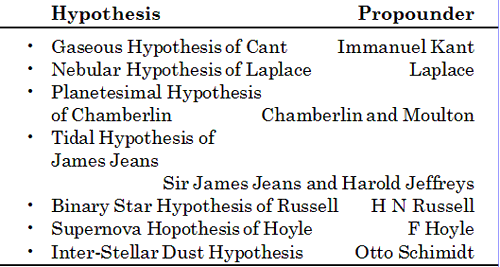
Big Bang Theory
The Big Bang Theory postulated in 1950’s and 1960’s and validated in 1972 (May) through convincing evidences received from COBE (Cosmic Background Explorer) explains the origin of universe and everything in it including ourselves on the premise that the universe contained many million of gallaxies, each one ‘having thousands of millions of stars and each star having numerous planets around them’. According to this theory everything in the universe emerged from a point known as singularity, 15 billion years ago. The galaxies moved apart from one another as the empty space between them expanded. In the beginning the universe was much smaller as there was less space between the galaxies. All of the matter in the universe was greated in one instant at a fixed moment in time. “As the universe expanded for 15 billion years, the hot radiation in the original fireball also expanded with it, and cooled as a result.” It may be summerized that there was a single fireball some 15 billion years ago. ‘There were already wispy clouds of matter stretching across vast distances, upwards 500 million light years across. As those coulds collaposed in upon themselves, pulled together by their own gravity, they would have broken up and formed clusters of galaxies with the galaxies themselves breaking up into stars like those of the Milky Way’ (John Gribbin). The stars might have broken up to form their planets as our earth.
Electromagnetic Radiation
The electromagnetic radiation emitted from the outer surface of the sun consists of four spectra of radiation waves.
- The first spectrum of the electromagnetic waves includes game rays, hard x-rays, soft x-rays and ultra violet rays.
- The second spectrum of the electromagnetic radiation waves also called the spectrum of visible light, includes violet, blue, green, yellow, orange and red rays.
- Third spectrum of the electromagnetic radiation waves is called as infrared spectrum.
- Fourth spectrum of the electromagnetic radiation wave consists of longwaves including microwaves, radar waves and radio waves.
- Anomalous rotation directions/axis tilts explained by collisions between planetismals as planets formed
Solar Statistics
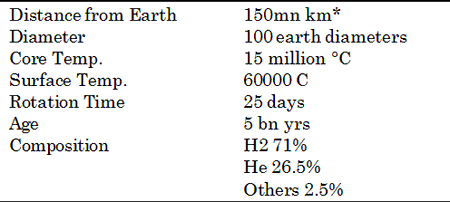
*Distance of Earth from Sun
Aphelion (max) - 152mn km on July 4
Perihelion (min) - 147mn km on January 3
- Turbulence/eddies in solar nebula led to formation of planetismals
- Compositional variation among planets is related to distance from Sun
- Hot inner portion of nebula, rock and metallic elements condensed out first, at high T. - Result: inner planets are “terrestrial” in composition.
- Outer portion of nebula is cooler, so gaseous phases such as H, He, methane, ammonia condensed out. Result outer planets are “Jovian” in composition.
- Suns magnetic field interacted strongly with ionized nebular gases- resulted in loss of solar rotational speed.
- Early in life, Sun emitted a large blast which blew away uncondensed material.
- Asteroid belt formed because tremendous gravitational field of Jupiter prevented planetismals from accreting into a planet.
The Sun
- The Sun accounts for 99.85% of mass of the solar system.
- The immense gravitational pull of the Sun keeps the planets rotating around it in definite orbits.
- It continuously gives off energy in the form of visible light, infra red, ultra violet, X-rays, gamma rays, radio waves and plasma.
- The period of revolution of the Sun around the galactic centre is 250 million years. This period is called a Cosmic or Galactic Year.
- Like all other stars, the Sun is mainly composed of hydrogen and helium. Nuclear fusion in the core of the Sun is source of all its energy.
- The glowing surface of the Sun, that we see, is called the Photosphere. Above the photosphere is the red coloured Chromosphere and beyond it is the magnificent Corona, which is visible during eclipses.
- The Sun is continuously emitting streams of protons in all directions either as persistent spiral streams called Solar Winds or as bouts of incandescent material called Solar Flares.
- The constituent particles of solar wind are trapped by the earth’s magnetic field and enter the earth’s upper atmosphere as auroral displays described as Aurora borealis in the northern hemisphere and Aurora australis in the southern hemisphere.
- Solar flares being hot ionised gases pose danger to satellite communication.
- The surface of the sun changes continuously. Bright spots called Plages and dark spots called Sunspots frequently form and disappear.
- Sunspots are cold and dark regions on the surface of the sun with a periodicity of 11 years. These spots greatly influence the global climate.
Planet
A planet is a celestial body orbiting a star or stellar remnant that is massive enough to be rounded by its own gravity, is not massive enough to cause thermonuclear fusion, and has cleared its neighbouring region ofplanetesimals. The term planet is ancient, with ties to history, science, mythology, and religion. The planets were originally seen by many early cultures as divine, or as emissaries of the gods. As scientific knowledge advanced, human perception of the planets changed, incorporating a number of disparate objects. In 2006, the International Astronomical Union officially adopted a resolution defining planets within the Solar System. This definition has been both praised and criticized, and remains disputed by some scientists since it excludes many objects of planetary mass based on where or what they orbit.
The planets were thought by Ptolemy to orbit the Earth in deferent and epicycle motions. Though the idea that the planets orbited the Sun had been suggested many times, it was not until the 17th century that this view was supported by evidence from the first telescopic astronomical observations, performed by Galileo Galilei. By careful analysis of the observation data, Johannes Kepler found the planets’ orbits to be not circular, but elliptical. As observational tools improved, astronomers saw that, like Earth, the planets rotated around tilted axes, and some shared such features as ice caps and seasons. Since the dawn of the Space Age, close observation by probes has found that Earth and the other planets share characteristics such as volcanism, hurricanes, tectonics, and even hydrology.
Planets are generally divided into two main types: large, low-density gas giants, and smaller, rocky terrestrials. Under IAU definitions, there are eight planets in the Solar System. In order of increasing distance from the Sun, they are the four terrestrials, Mercury, Venus, Earth, and Mars, then the four gas giants, Jupiter, Saturn, Uranus, and Neptune. Six of the planets are orbited by one or more natural satellites. Additionally, the Solar System also contains at least five dwarf planets[3] and hundreds of thousands of small Solar System bodies.
Since 1992, hundreds of planets around other stars (“extrasolar planets” or “exoplanets”) in the Milky Way Galaxy have been discovered. As of February 14, 2012, 760 known extrasolar planets (in 609 planetary systems and 100 multiple planetary systems) are listed in the Extrasolar Planets Encyclopaedia, ranging in size from that of terrestrial planets similar to Earth to that of gas giants larger than Jupiter. On December 20, 2011, the Kepler Space Telescope team reported the discovery of the first Earth-sized extrasolar planets, Kepler-20e and Kepler-20f, orbiting a Sun-like star, Kepler-20. A 2012 study, analyzing gravitational microlensing data, estimates an average of at least 1.6 bound planets for every star in the Milky Way.
According to the IAU, there are eight planets and five recognized dwarf planets in the Solar System. In increasing distance from the Sun, the planets are:
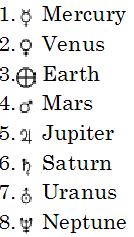
Jupiter is the largest, at 318 Earth masses, while Mercury is smallest, at 0.055 Earth masses.
The planets of the Solar System can be divided into categories based on their composition:
-
Terrestrials: Planets that are similar to Earth, with bodies largely composed of rock: Mercury, Venus, Earth and Mars. At 0.055 Earth masses, Mercury is the smallest terrestrial planet (and smallest planet) in the Solar System, while Earth is the largest terrestrial planet.
-
Gas giants (Jovians): Planets largely composed of gaseous material and significantly more massive than terrestrials: Jupiter, Saturn, Uranus, Neptune. Jupiter, at 318 Earth masses, is the largest planet in the Solar System, while Saturn is one third as big, at 95 Earth masses.
-
Ice giants, comprising Uranus and Neptune, are a sub-class of gas giants, distinguished from gas giants by their significantly lower mass (only 14 and 17 Earth masses), and by depletion in hydrogen and helium in their atmospheres together with a significantly higher proportion of rock and ice.
-
Dwarf planets: Before the August 2006 decision, several objects were proposed by astronomers, including at one stage by the IAU, as planets. However in 2006 several of these objects were reclassified as dwarf planets, objects distinct from planets. Currently five dwarf planets in the Solar System are recognized by the IAU: Ceres, Pluto, Haumea, Makemake and Eris. Several other objects in both the Asteroid belt and the Kuiper belt are under consideration, with as many as 50 that could eventually qualify. There may be as many as 200 that could be discovered once the Kuiper belt has been fully explored. Dwarf planets share many of the same characteristics as planets, although notable differences remain – namely that they are not dominant in their orbits. By definition, all dwarf planets are members of larger populations. Ceres is the largest body in the asteroid belt, while Pluto, Haumea, and Makemake are members of the Kuiper belt and Eris is a member of the scattered disc. Scientists such as Mike Brown believe that there are probably over one hundred trans-Neptunian objects that qualify as dwarf planets under the IAU’s recent definition.
In order from closest to furthest from the sun:
- Mercury
- Venus
- Earth
- Mars
- Ceres (dwarf planet found in the asteroid belt)
- Jupiter
- Saturn
- Uranus
- Neptune
(Note: Pluto is considered a dwarf planet now) Eris, Makemake, Haumea, Sedna (also dwarf planets — found past Pluto)
Mercury takes 59 days to make a rotation but only 88 days to circle the Sun. That means that there are fewer than 2 days in a year! Many astronomers believe that Mercury might be the core of what was once a much larger planet — it appears to be a huge ball of iron covered by a thin layer of rock.
Venus is the brightest planet in our sky and can sometimes be seen with the
naked eye if you know where to look. It is the solar system’s brightest planet —
yellow clouds of sulfuric acid reflect the sun’s light brightly.
Earth has more exposed water than land. Three quarters of the Earth is covered
by water!
Mars is the home of “Olympus Mons”, the largest volcano found in the solar system. It stands about 27 kilometers high with a crater 81 kilometers wide.
Between Mars and Jupiter, is a Dwarf Planet known as Ceres. It was discovered in 1801. It is the smallest dwarf planet discovered in our universe (so far) and is the only one found in the asteroid belt.
Jupiter is the largest planet in the solar system, but it spins very quickly on its axis. A day on Jupiter lasts only 9 hours and 55 minutes. Ack, I get dizzy just thinking about it!
Jupiter is so big that you could fit all the other planets in the solar
system inside it. The red spot of Jupiter is the biggest, most violent storm in
the known universe — that spot is at least three times the size of earth!
Saturn is the second biggest planet, but it’s also the lightest planet. If there
was a bathtub big enough to hold Saturn, it would float in the water!
The ring that surrounds Saturn could be the remnants of a moon that was shattered by Saturn’s gravity.
Uranus’ axis is at a 97 degree angle, meaning that it orbits lying on its side! Talk about a lazy planet.
The Planets
All the planets except Pluto are grouped into two classes:
1. Terrestrial (Earth like) planets which have dense rocky bodies and include
Mercury. Venus, Earth and Mars. These are also called inner planets.
2. Jovian (Jupiter like) planets which are gaseous, gigantic, with large
satellite families and high rotational velocities. These include Jupiter,
Saturn, Uranus and Neptune. These are also called outer planets.
Mercury
- The Innermost Planet is also the swiftest and smallest planet.
- It has no atmosphere and has a cratered surface. much like the moon’s.
- It has the maximum diurnal range of temperature and the shortest year.
Mercury
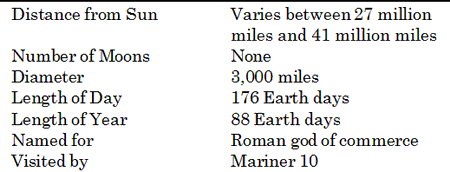
Venus
- The Veiled Planet is second only to the Moon in brilliance in the night sky and is better known as the Evening or the Morning Star.
- It is also called the Earths twin because of its similar size, density and mass.
- Unlike other planets it rotates from east to west.
- It is the hottest planet and also has the slowest rotational velocity with a period of rotation nearly the same as that of revolution.
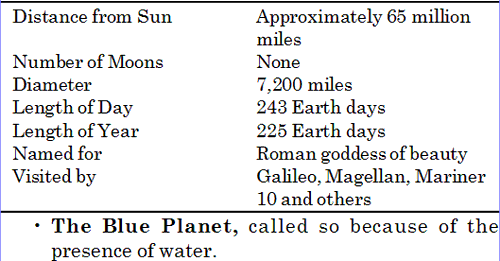
Earth
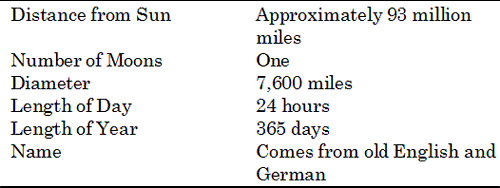
- It is the third planet from the Sun and the fifth in size.
- It is the densest of all and is unique for the presence of higher forms of life!
In the Solar System, our Earth is a unique planet because of the life forms that exists on its surface. Somewhat more than a decade ago, it was recognized that the Earth is a sub system in which, its nonliving elements such as oceans, atmosphere, and land and the living parts are all connected. While accepted by many, this working hypothesis seldom formed the basis for global change research. Little understanding existed of how the Earth worked as a system, how the parts were connected, or even about the importance of the various components of the system. Over the intervening years, much has been learned. In many respects, former uncertainties about the nature and future course of global change have been reduced, in others, the realization that uncertainty is an inherent part of the system has gained credibility. Over the last thirty years, the understanding of how humans are bringing about global change has undergone a quantum jump.
Attempts to separate natural and anthropogenically induced variability in the Earth System have proved to be successful in many respects. Largely through a significant increase in the ability to unravel the past history, our understanding of the natural dynamics of the Earth System has advanced greatly. It is now clear that global change is one of the paramount environmental issues facing humanity at present. Due to a decade of global change research, some of the important research findings that have emerged are as follows :
1. Earth functions as a system. This system has components and controls the system themselves. Living organisms interact with land, water and atmosphere and create the planetary environment.
2. Global change is much more than climate change. It is real, it is happening now, and it is accelerating. Human activities are significantly influencing the functioning of the Earth System in many ways. Anthropogenic changes are clearly identifiable beyond natural variability and are equal to some of the great forces of nature in their extent and impact.
3. Global change cannot be understood in terms of a simple cause/effect paradigm. Because, the human inventions and technology multiply the interacting effects that cascade through the Earth System in complex ways. Cascading effects of human activities interact with each other and with local, and regional, scale changes in multidimensional ways. So, understanding a changing Earth demands an effective framework between the social and natural sciences. One such framework is the concept of an Earth System introduced by a Russian mineralogist, Vladimir Vernadsky, in the year 1920s. According to him, “Earth’s environment is an integrated global system with significant connections among its atmosphere, ocean, land and living biota”.
